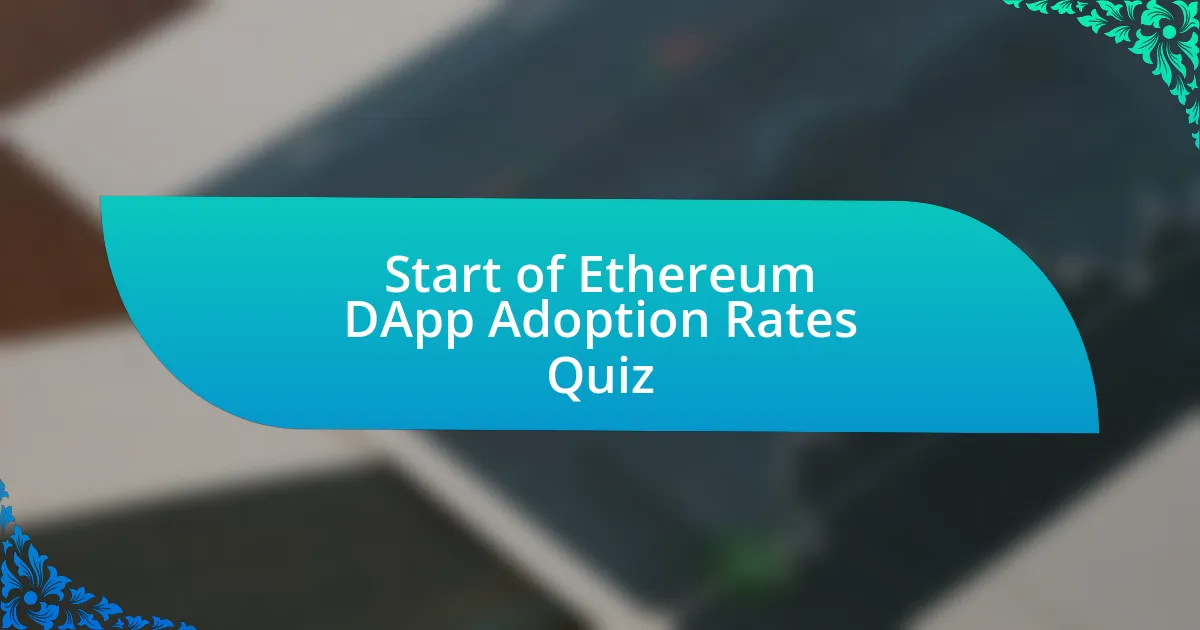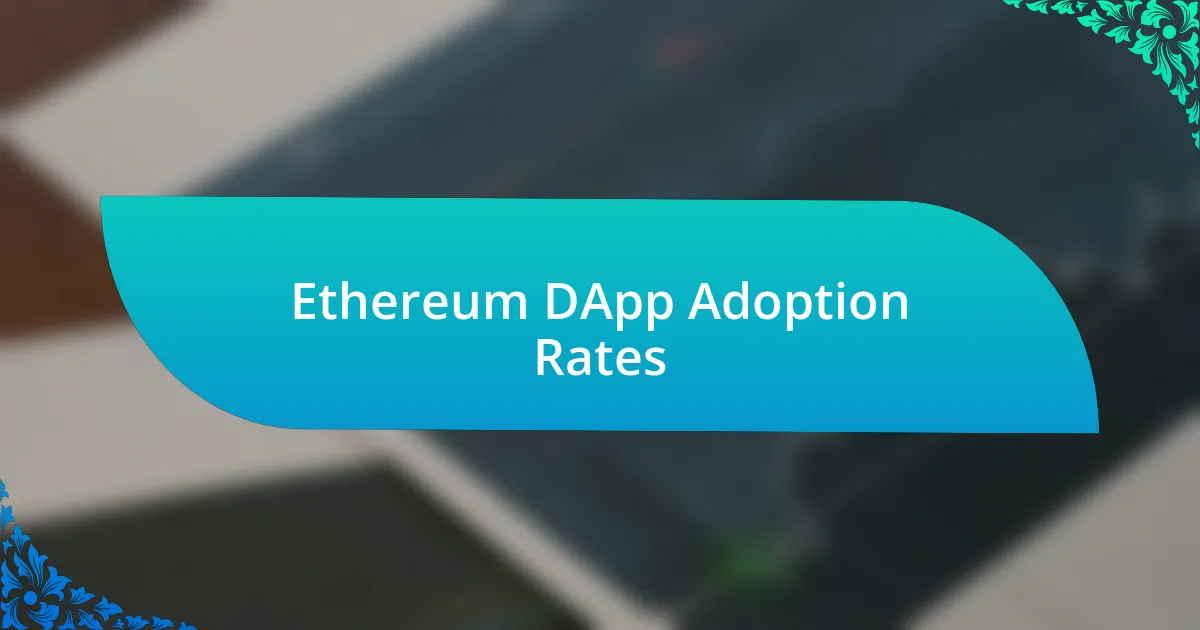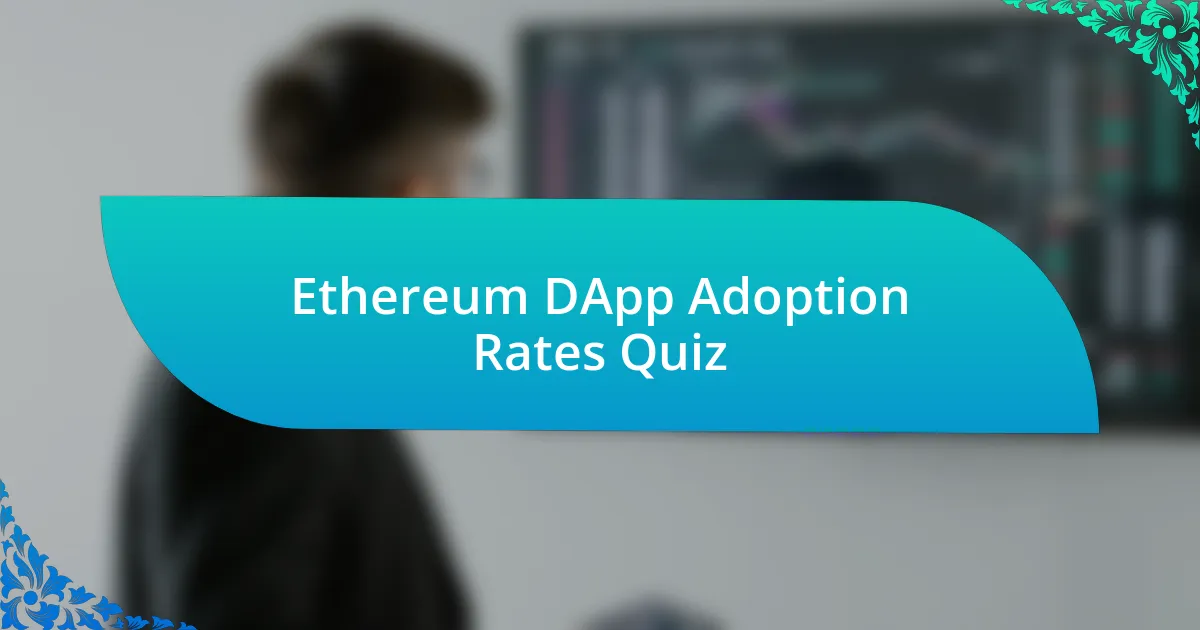
Start of Ethereum DApp Adoption Rates Quiz
1. What is the current trend in Ethereum DApp adoption rates?
- Ethereum DApp adoption rates have decreased by over 50% in the last month.
- Ethereum DApp adoption rates have consistently declined every week since the beginning of the year.
- The Ethereum DApp adoption rates have seen a significant surge, with a reported 83% increase in volume over the previous week.
- Ethereum DApp adoption rates have stagnated with no notable changes reported in the last few weeks.
2. Which blockchain network reported an increase in DApp volume?
- Ethereum
- BNB Chain
- NEO
- Tron
3. What percentage of Ethereum`s DApp volume was attributed to Balancer?
- 59.5%
- 33.3%
- 42.1%
- 75.2%
4. How much did Balancer`s volume increase over seven days?
- 150%
- 422%
- 200%
- 300%
5. What is the primary driver of Ethereum`s DApp volume growth?
- Increased NFT sales
- New blockchain partnerships
- Ethereum`s price spike
- Balancer`s significant activity
6. How does Balancer`s activity compare to other blockchains?
- Balancer`s activity is less than that of Solana during the same period.
- Balancer`s activity is twice the activity of Cardano.
- Balancer`s activity is 13 times more than the total activity on BNB Chain during the same period.
- Balancer`s activity is equal to the total activity on BNB Chain.
7. What is the impact of high transaction fees on Ethereum`s DApp adoption?
- High transaction fees on Ethereum lead to an increase in DApp development activity.
- High transaction fees on Ethereum might discourage user adoption, despite the significant volume growth.
- High transaction fees on Ethereum boost the number of unique active addresses.
- High transaction fees on Ethereum have no impact on user interest or engagement.
8. Did the number of unique active addresses on Ethereum increase with the volume surge?
- No, the number of active addresses increased by 5%.
- No, the number of active addresses decreased.
- Yes, the number of active addresses stayed the same.
- Yes, the number of active addresses tripled.
9. What role do DeFi applications play in Ethereum`s DApp adoption?
- DeFi applications play a significant role in Ethereum`s DApp adoption, with substantial deposits exceeding $1 billion.
- DeFi applications only affect Bitcoin`s adoption and not Ethereum`s.
- DeFi applications have no influence on Ethereum`s DApp adoption whatsoever.
- DeFi applications mainly serve as a means for centralized exchanges to control the market.
10. How did the total value locked in DeFi applications on Ethereum change over seven days?
- The total value locked in DeFi applications on Ethereum increased by 25% over seven days.
- The total value locked in DeFi applications on Ethereum remained unchanged over seven days.
- The total value locked in DeFi applications on Ethereum fell by 17.5% over seven days.
- The total value locked in DeFi applications on Ethereum fell by 5% over seven days.
11. Which consensus algorithm does Ethereum currently use?
- Proof-of-Work
- Practical Byzantine Fault Tolerance
- Proof-of-Stake
- Delegated Proof-of-Stake
12. What are smart contracts, and how are they used in DApps?
- Smart contracts are network protocols that do not involve any code and operate only manually in DApps.
- Smart contracts are traditional legal contracts written on paper, used for negotiation purposes in DApps.
- Smart contracts require physical documents to enforce agreements and are only used in centralized applications.
- Smart contracts are self-executing contracts with the terms of the agreement written directly into code. They are used to automate various processes in DApps.
13. Where are transactions recorded on the Ethereum network?
- Local server
- Private cloud
- Public ledger
- Centralized database
14. What is the primary reason for Ethereum`s dominance in DApp development?
- Lack of smart contracts
- Robust developer community
- Limited transaction speed
- High transaction fees
15. What is the ERC-20 tokenization standard, and how does it facilitate DApp activity?
- The ERC-20 tokenization standard allows tokens to operate only on private blockchains, preventing dApp integration.
- The ERC-20 tokenization standard restricts interaction between Ethereum-based tokens, limiting dApp activity.
- The ERC-20 tokenization standard ensures that Ethereum-based tokens can interact seamlessly with one another, facilitating dApp activity.
- The ERC-20 tokenization standard is a proprietary protocol used only by Bitcoin, hindering dApp development.
16. How do DApps on Ethereum monetize their assets?
- dApps monetize their assets by issuing bonds through a government.
- dApps monetize their assets by trading on exchanges or launching decentralized exchanges (DEXs).
- dApps monetize their assets through advertising on traditional websites.
- dApps monetize their assets by creating physical stores and selling products.
17. What is the role of MetaMask in interacting with DApps on the Ethereum network?
- MetaMask is a consensus mechanism employed by Ethereum for transaction validation.
- MetaMask is a blockchain explorer for tracking Ethereum transactions.
- MetaMask is a popular browser-based Ethereum wallet used to interact with dApps on the Ethereum network.
- MetaMask is a framework for developing Ethereum smart contracts.
18. What is Truffle, and what does it provide for developers?
- Truffle is a decentralized platform that allows users to trade digital assets.
- Truffle is a cryptocurrency wallet that manages Ether and token transactions.
- Truffle is a testing and development environment for Ethereum that provides tools for creating smart contracts, automated testing, and configuring pipelines.
- Truffle is an exchange for buying and selling cryptocurrencies.
19. How do block time and average block size affect Ethereum`s performance?
- The block time is 20 seconds, and the average block size is 3 KB.
- The block time is 12 seconds, and the average block size is 4 KB.
- The block time is 14 seconds, and the average block size is 2 KB.
- The block time is 10 seconds, and the average block size is 1 KB.
20. Can transactions be kept hidden on the Ethereum network?
- Only selected transactions are visible while others remain hidden.
- No, all transactions on the public Ethereum network are public.
- Transactions can be encrypted for privacy on the Ethereum network.
- Yes, transactions can be kept completely anonymous on Ethereum.
21. Is the user`s private key used to sign transactions?
- Yes, the user`s private key is used to create wallets.
- Yes, the user`s private key is used to sign transactions.
- No, the user`s private key is used to encrypt data.
- No, the user`s private key is used for transaction storage.
22. What is the purpose of a testnet in Ethereum development?
- A testnet is a place to trade real Ether with no fees.
- A testnet is a backup system for the main Ethereum network.
- A testnet is used for testing smart contracts without using real Ether.
- A testnet is a layer of security against hacking.
23. Do you need to use real Ether to test DApps and smart contracts?
- No, only Bitcoin can be used in testing.
- No, free Ether can be used in test networks.
- Yes, real Ether is mandatory for all testing.
- Yes, real Ether is needed occasionally for testing.
24. How does spending work in smart contracts?
- Spending in smart contracts that modify the contract incurs gas costs.
- Spending in smart contracts is always free of charge.
- Spending in smart contracts requires a specific token type.
- Spending in smart contracts incurs a flat fee regardless of actions.
25. What is Remix, and what does it provide for developers?
- Remix is a social media platform for connecting developers.
- Remix is a gaming application for blockchain-based games.
- Remix is a cryptocurrency wallet for managing digital assets.
- Remix is a tool for developers to write, test, and debug Solidity smart contracts.
26. What is the primary driver of DApp revenue growth?
- The increasing adoption of trading bots and decentralized exchanges
- The decline in Ethereum transaction fees
- The popularity of traditional financial institutions
- The rise of speculative memecoins trading
27. Which blockchains are among the top revenue-generating networks for DApps?
- Ripple, Cardano, and Stellar
- Bitcoin, Litecoin, and Dogecoin
- Monero, Dash, and Zcash
- Ethereum, Tron, and Solana
28. What is the total monthly revenue generated by DApps across top blockchains?
- $150 million
- $250 million
- $200 million
- $182 million
29. What is the speculation driving revenues in the DApp market?
- P2P lending growth
- Speculative trading of memecoins
- Centralized exchange listings
- Stablecoin issuance
30. What is the role of decentralized applications (DApps) in blockchain adoption?
- dApps only serve to confuse users and limit blockchain growth.
- dApps are irrelevant to blockchain adoption and have no impact.
- dApps are hindering blockchain adoption due to high transaction fees.
- dApps are driving blockchain adoption, fueled by trading bots and decentralized exchanges.

Quiz Successfully Completed!
Congratulations on finishing the quiz on Ethereum DApp adoption rates! We hope you found it both informative and engaging. It’s an exciting time for Ethereum and decentralized applications. You may have discovered statistics that highlight growth trends, user demographics, and the overall impact of these technologies on various industries.
This quiz was designed to sharpen your understanding of Ethereum’s ecosystem. You likely learned how DApps operate differently from traditional applications. Increased adoption is shaping the future of finance, gaming, and even social media platforms. Understanding these concepts is essential as the technology evolves.
We invite you to explore the next section on this page. You’ll find deeper insights into Ethereum DApp adoption rates. This resource will expand on what you’ve learned today. Knowledge is your best tool in navigating the rapidly changing landscape of blockchain technology. Happy learning!

Ethereum DApp Adoption Rates
Overview of Ethereum and DApps
Ethereum is a decentralized blockchain platform that enables developers to build decentralized applications (DApps). DApps operate autonomously, leveraging smart contracts to execute predefined rules without reliance on a central authority. This open-source framework supports various applications, including finance, gaming, and social media. The broad potential of Ethereum DApps drives interest and investment, establishing Ethereum as a leading network in the decentralized technology landscape.
Current Adoption Rates of Ethereum DApps
As of late 2023, Ethereum DApp adoption rates have shown significant growth. Approximately 70% of all DApps are built on the Ethereum network, reflecting its dominance in the market. The total number of active DApps on Ethereum reached over 4,000, with participants increasingly engaging in DeFi, NFTs, and gaming sectors. The rise in adoption is supported by factors such as improved scalability solutions and user-friendly interfaces.
Factors Influencing Ethereum DApp Adoption
Several factors influence Ethereum DApp adoption rates. Scalability solutions, like Ethereum 2.0, enhance transaction speeds and reduce fees, making DApps more accessible. User experience also plays a significant role; DApps that provide intuitive interfaces attract more users. Moreover, the growing popularity of decentralized finance (DeFi) and non-fungible tokens (NFTs) creates a more favorable environment for DApp utilization.
Challenges to Ethereum DApp Adoption
Despite its growth, Ethereum DApps face challenges that affect adoption rates. High transaction costs, often due to network congestion, deter potential users. Security vulnerabilities in smart contracts raise concerns about risks associated with DApps. Additionally, user education remains a barrier; many potential users lack an understanding of blockchain technology and DApps, hindering widespread usage.
Future Projections for Ethereum DApp Adoption
Future projections for Ethereum DApp adoption remain optimistic. Analysts expect continued growth as scalability improvements and layer 2 solutions are implemented. Adoption in emerging markets is likely to increase due to rising interest in crypto assets. Furthermore, innovations in user education and interfaces will enhance accessibility, potentially leading to mainstream acceptance of Ethereum DApps.
What are the current adoption rates of Ethereum DApps?
As of 2023, the adoption rate of Ethereum DApps has seen significant growth, with over 3 million active monthly users. Reports indicate that the number of daily transactions within Ethereum DApps exceeds 1 million, reflecting robust user engagement and increasing trust in decentralized applications.
How does Ethereum DApp adoption compare to other blockchain platforms?
Ethereum DApp adoption is substantially higher than that of other blockchain platforms. Approximately 90% of all DApps are built on Ethereum, showcasing its dominance in the space. Competing platforms, like Binance Smart Chain, have a smaller percentage of DApp deployments, around 7%, highlighting Ethereum’s leading position in DApp development.
Where are the majority of Ethereum DApps being used?
The majority of Ethereum DApps are utilized within the decentralized finance (DeFi) sector, accounting for over 60% of all DApps. Gaming and non-fungible tokens (NFTs) also represent significant portions, with DeFi transactions reaching upwards of $80 billion in total value locked, illustrating the impact of these applications in various market segments.
When did Ethereum DApp adoption begin to increase significantly?
Ethereum DApp adoption began to increase significantly in 2020, coinciding with the DeFi boom. During this period, the total value locked in DeFi protocols surged from $1 billion to over $40 billion by the end of the year, marking a pivotal moment in the recognition and usage of DApps on the Ethereum network.
Who are the primary users of Ethereum DApps?
The primary users of Ethereum DApps include retail investors, developers, and crypto enthusiasts. Retail users are drawn to DeFi applications for financial opportunities, while developers seek to build innovative solutions, making them integral to the ecosystem. Surveys indicate that over 70% of users are under 35 years old, showing a younger demographic engagement.

